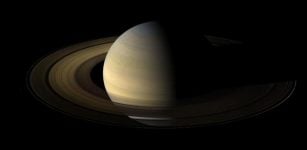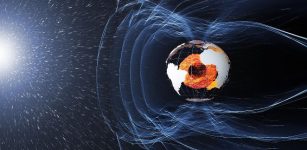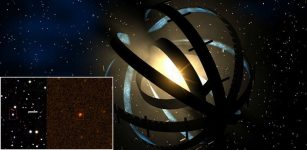Extreme Weather Patterns And Atmospheric Properties Of An ‘Ultra-Hot Neptune’
Eddie Gonzales Jr. – MessageToEagle.com – The James Webb Space Telescope is revealing the exotic atmosphere of LTT 9779 b, a rare “ultra-hot Neptune,” through observations led by Louis-Philippe Coulombe, a doctoral student at Université de Montréal’s Trottier Institute for Research on Exoplanets (IREx).
Illustration of LTT 9779 b, the only known ultra-hot Neptune. This planet orbits so close to its star that its atmosphere is scorching hot, glowing from its own heat while also reflecting starlight. Because it is tidally locked – always showing the same side to its star – one half is permanently in daylight while the other remains in darkness. New JWST observations with NIRISS reveal a dynamic atmosphere: powerful winds sweep around the planet, shaping mineral clouds as they condense into a bright, white arc on the slightly cooler western side of the dayside. As these clouds move eastward, they evaporate under the intense heat, leaving the eastern dayside with clear skies. Credit: Benoit Gougeon, Université de Montréal
The observations by Coulombe and his team offer new insights into the extreme weather patterns and atmospheric properties of this fascinating exoplanet.
Orbiting its host star in less than a day, LTT 9779 b is subjected to searing temperatures reaching almost 2,000°C on its dayside. The planet is tidally locked (similar to Earth’s Moon), meaning one side constantly faces its star while the other remains in perpetual darkness.
Despite these extremes, Coulombe’s team discovered that the exoplanet’s dayside hosts reflective clouds on its cooler western hemisphere, creating a striking contrast to the hotter eastern side.
“This planet provides a unique laboratory to understand how clouds and the transport of heat interact in the atmospheres of highly irradiated worlds,” said Coulombe.
Asymmetry on the dayside
Using the James Webb Space Telescope (JWST), his team uncovered an asymmetry in the planet’s dayside reflectivity. The scientists propose that the uneven distribution of heat and clouds is driven by powerful eastward winds that transport heat around the planet.
These findings help refine models describing how heat is transported across a planet and cloud formation in exoplanet atmospheres, thereby also helping bridge the gap between theory and observation.
The research team analyzed the planet’s atmosphere by studying its emitted heat and reflected light. They observed the planet at various orbital positions, analyzing its properties at each phase. They discovered silicate mineral clouds forming arch-like shapes on the cooler western dayside, reflecting much of the star’s light and explaining the planet’s brightness in visible wavelengths.
Combining reflected light and heat emissions, the team created a detailed model of the planet’s atmosphere. Their findings show a balance between intense star heat and the planet’s energy redistribution. The study also detected water vapor, offering clues about the planet’s composition and extreme environmental processes.
“By modeling LTT 9779 b’s atmosphere in detail, we’re starting to unlock the processes driving its alien weather patterns,” said Coulombe’s research advisor Björn Benneke, an UdeM physics professor and co-author of the study.
An incredibly powerful telescope
With this study, the JWST has once again demonstrated its incredible power, allowing scientists to study the atmosphere of LTT 9779 b in unprecedented detail.
Its Canadian instrument, the Near Infrared Imager and Slitless Spectrograph (NIRISS), was used to observe the planet for nearly 22 hours. The data captured the planet’s full orbit around its star, including two secondary eclipses (when the planet passes behind its star) and a primary transit (when the planet passes in front of its star).
For an exoplanet like LTT 9779 b, which is tidally locked to its star, the amount and type of light that’s observed changes as the planet rotates, showing us different parts of its surface. The dayside reflects and emits more light due to intense heating, while the cooler nightside emits less light. By capturing spectra at various phases, researchers can map out variations in temperature, composition and even cloud coverage across the planet’s surface.
Michael Radica, a former PhD student at UdeM and now a postdoctoral researcher at the University of Chicago, was the second author of this study. Earlier this year, he published a detailed analysis of the planet’s light spectrum during transit. “It’s remarkable that both types of analyses paint such a clear and consistent picture of the planet’s atmosphere,” he noted.
The research was conducted as part of the NEAT (NIRISS Exploration of Atmospheric Diversity of Transiting Exoplanets) Guaranteed Time Observation program, led by IREx’s David Lafrenière, an UdeM physics professor.
The study highlights the importance of JWST’s ability to observe exoplanets across a wide wavelength range, allowing scientists to disentangle the contributions of reflected light and thermal emission, he said.
“This is exactly the kind of groundbreaking work JWST was designed to enable.”
Remarkably rare hot Neptunes
LTT 9779 b resides in the “hot Neptune desert,” where exceptionally few such planets are known to exist. While giant planets orbiting very close to their host stars—often called “hot Jupiters”—are commonly detected using current exoplanet-finding methods, ultra-hot Neptunes like LTT 9779 b remain remarkably rare.
“Finding a planet of this size so close to its host star is like finding a snowball that hasn’t melted in a fire,” said Coulombe. “It’s a testament to the diversity of planetary systems and offers a window into how planets evolve under extreme conditions.”
This rare planetary system continues to challenge scientists’ understanding of how planets form, migrate, and endure in the face of unrelenting stellar forces. LTT 9779 b’s reflective clouds and high metallicity may shed light on how atmospheres evolve in extreme environments, too.
LTT 9779 b is a remarkable laboratory for exploring these questions, offering insights into the broader processes that shape the architecture of planetary systems across the galaxy, said Coulombe.
“These findings give us a new lens for understanding atmospheric dynamics on smaller gas giants. This is just the beginning of what JWST will reveal about these fascinating worlds.”
Written by Eddie Gonzales Jr. – MessageToEagle.com Staff Writer











